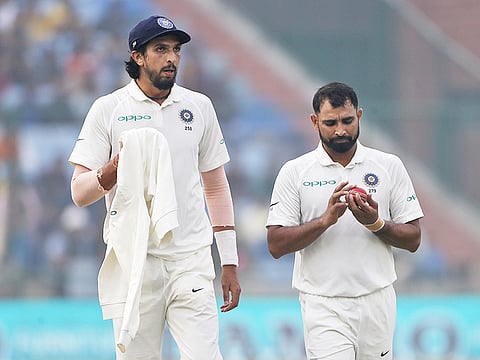Work ethic is the key to Indian pacers’ success, Bharat Arun says
Indian team bowling coach talks about the science of fast bowling

Dubai: Bharat Arun, the bowling coach of the Indian team, once again reiterated the importance of hard work and identified the pace bowling unit’s success is due to their work ethic.
The Indian pacers, consisting of Jasprit Bumrah, Mohammad Shami, Umesh Yadav, Ishant Sharma and Bhuvneshwar Kumar is one of the fearsome units in world cricket today as they hunt in a pack, carrying the team’s fortunes on their strong shoulders to the top of the chart over the last few years.
Arun, speaking on the importance of training in a video show ‘Inside Out: The science of fast bowling,’ hosted by former Indian opener and current Indian women’s team coach Woorkeri Raman, said: “The way the Indian fast bowlers train, the results are there for you to see. They are very serious about their training schedules and do not miss a session. This has contributed to them being not only fit but also bowl consistently above 140kph.
“I am totally convinced that you need to be in training, like a racehorse, absolutely fit and raring to go for a fast bowler.”
You can’t control what is happening in a game where they will be bowling a lot more than usual. What we can monitor is practice and training workload after the game. Every player needs to get proper rest, we need to strike a right balance between skill and rest

Cricket, as much as fast bowling, is a science and hence the sport has imbibed many scientific approaches on various aspects of the game, like analysing through video analysis and biomechanics, managing the workload using a GPS tracker.
Handling the Indian pacers is no mean task as they are a priceless commodity. Hence Arun, along with head coach Ravi Shastri and the support staff, have a big task of managing their workload to keep them generally “injury free and efficient”. The job gets trickier if one has to handle unconventional bowlers like Bumrah, who puts a lot of strain on his body.
“You can’t control what is happening in a game where they will be bowling a lot more than usual. What we can monitor is practice and training workload after the game. Every player needs to get proper rest, we need to strike a right balance between skill and rest.”
So is there any strict guidelines on how many deliveries a bowler has to bowl in a week?
“I cannot be very strict and stop after bowling 120 balls (as per the guidelines). If I am working on something and he needs to bowl more than I compensate it by giving him some days off so that he gets the right amount of rest. I work around the guidelines, plus or minus.”
So what is the key aspect in training of a fast bowler, is it the speed, strength, agility or endurance?
“All these parameters are important. In cricket, everything is about speed, be it batting, bowling or fielding. How quickly you recover is vital.”
Talking about injuries in cricket, Arun, whose career was cut short by a knee injury, said one has to wear the right playing equipment, especially a good pair of bowling shoes — a rarity those days. Certainly he must have learnt the lesson the hard way! Just imagine him running to bowl the first ball in Test cricket and slipping on his delivery stride, after playing for many years and bowling hundreds of deliveries before making the grade.
Today, each team has a battery of support staff looking into various aspects of the game and one key area is the video analysis. “It’s like a fire. It can be your friend and your enemy too. If you use it judiciously it can be your friend. It gives enormous feedback to improve and an important tool in my coaching career.”
The respected coach has a word of advice in training fast bowlers, who could be running around 20km in a whole day’s play. “One has to strike a fine balance between training and skill-work. Training and skill are 50-50, they need to complement each other.”
Arun also dwelt at length on the intricacies of the art of reverse swing, a much sought-after art in today's cricket.
Sign up for the Daily Briefing
Get the latest news and updates straight to your inbox



